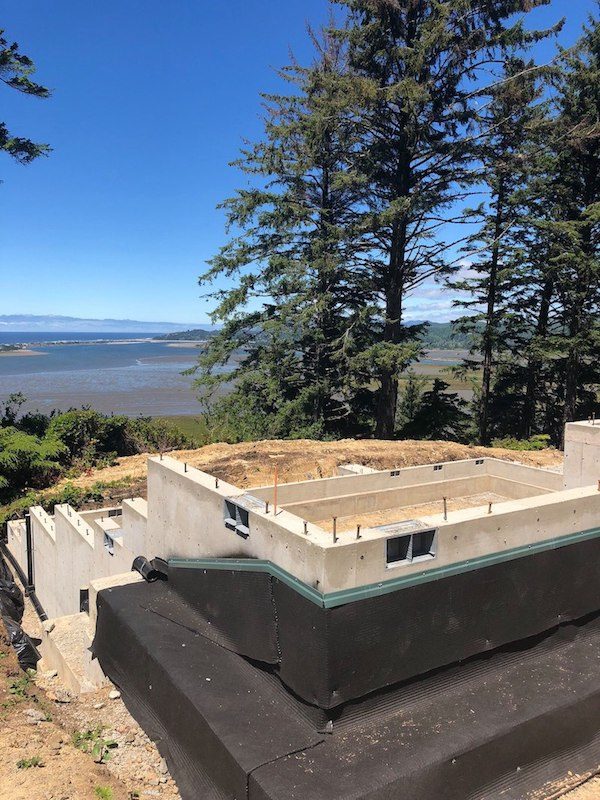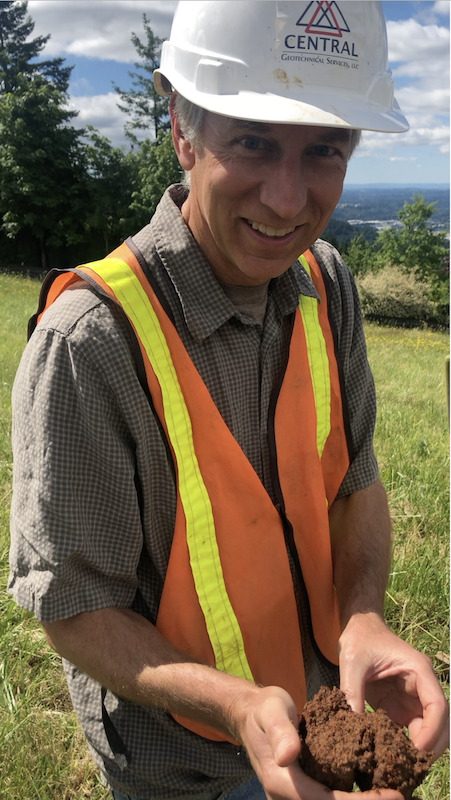
Building a home on a hillside or steep slope offers unique design opportunities and stunning views — but it’s not without challenges. A successful steep slope construction project requires thorough planning and research to ensure you…
- Select the right piece of property
- Can construct a rock-solid home that’s built to last
Keep reading to learn 8 important soil and site factors your design-build team will help you consider before selecting a homesite for your steep slope construction.
1. What is the property’s slope?
The steepness of your property can be expressed in degrees or percentages. Accurately calculating the slope of your property is critical for many reasons:
- It’s important to understand and apply code requirements
- Will help you determine your foundation wall heights
- Determines fill and grade quantities
- Determines overall site stability
- Helps with surface runoff calculations
2. What’s the surface texture of your soil?
Surface texture refers to the amount of sand, silt, and clay in the soil. It’s important to gauge the surface texture of the soil on a steep sloping property as it will affect your foundation and landscaping abilities.
You can get a general idea of the surface texture of the soil by rubbing it between your fingers or hands — what do you feel?
- Silky clay texture — This type of soil is sticky when wet and very hard when dry. It is very difficult to work with, both when landscaping and constructing a foundation.
- Floury (loamy) feeling — This texture of soil is easy to excavate and ideal for landscaping and gardening. It absorbs wastewater quite well.
- Rough and gritty — This texture of soil will need significant moisture improvement if you want to use it for landscaping and growing. While this texture of soil is easy to excavate and absorbs wastewater quite well, erosion is a concern.
3. Have you measured soil permeability?
Soil permeability is the rate at which water enters and passes through the soil. Permeability will play an important factor in choosing a wastewater treatment system. You must take soil percolation tests before choosing the right system for your property.
For example, septic system costs can increase significantly for soil with a very slow permeability. This type of land requires extensive lateral drains or other expensive modifications.
4. Is the property at risk for mudslides or flooding?
You need to understand the rate that water flows off your site as well as the depth at which water occurs in the soil — both seasonally and permanently. This information will be based on the slope of your property, soil permeability, and soil texture. You should also consider the potential for landslides and flooding hazards.
While a geotech engineer is needed to accurately assess these conditions, you can contribute by:
- Noting if there are any streams or other surface water on the property
- Viewing the property in multiple weather conditions and seasons to see if the property is at greater risk of water issues at different times of the year
- Asking nearby residents about site conditions
5. Are there any erosion concerns?
Measuring topsoil is important for understanding the future potential of erosion. Ideally, you want topsoil that’s at least 6 inches thick. In extreme cases where topsoil is less than 3 inches (or even non-existent), you’ll need to plan for…
- Extensive filing and leveling
- More costly septic system installation
- Extensive landscaping modifications
Whether or not you have a thick layer of topsoil, it’s important to take erosion control measures during construction to ensure a rock-solid home.
6. Can you achieve the design you want on the property?

All the factors above combined with the size and location of the land will help to determine what may or may not be possible in terms of design and landscaping.
For example, steep slope homes are often designed with daylight basements — but perhaps that’s not something you envisioned for your home. Or maybe you’ve always wanted a swimming pool on your property, but it won’t be possible on this piece of property.
All said, don’t immediately discount a sloping property without first working with an expert. Modern advancements in the design-build industry open up a world of possibilities.
7. What specialized equipment will be necessary?
Sloping properties create a few logistical challenges when it comes to construction — particularly when it comes to equipment. Steep slope construction is often considered hazardous terrain and may require specific tools and machinery to get the job done correctly.
When you work with the right design-build team, they’ll understand what equipment is required. They’ll also know how to conduct any necessary equipment modifications while staying in accordance with industry best practices and manufacturer’s guidelines.
8. Do you understand the timeframe?
Building a home on a sloped lot often requires a bit of extra time — there are extra steps and more labor required to get the land to a safe and stable place. Work closely with a design-build expert to make sure you understand the timeframe, and possible delays, beforehand.
Always work with a steep slope construction expert

Whether or not you’re building on a steep slope, you should always have it reviewed by a qualified engineer.
At Westlake Development, we partner with local geotech engineers to investigate the soil and surrounding groundwork, provide essential documentation, and help with the construction process. Our team knows the proper way to place and construct a residence in the most structurally sound and cost-effective way — all while taking advantage of all the benefits the home site has to offer.
With over 30 years of experience constructing custom homes on steep slopes and other challenging properties, we provide peace of mind and an easy, enjoyable experience.
View our gallery of work or contact us to learn more.


